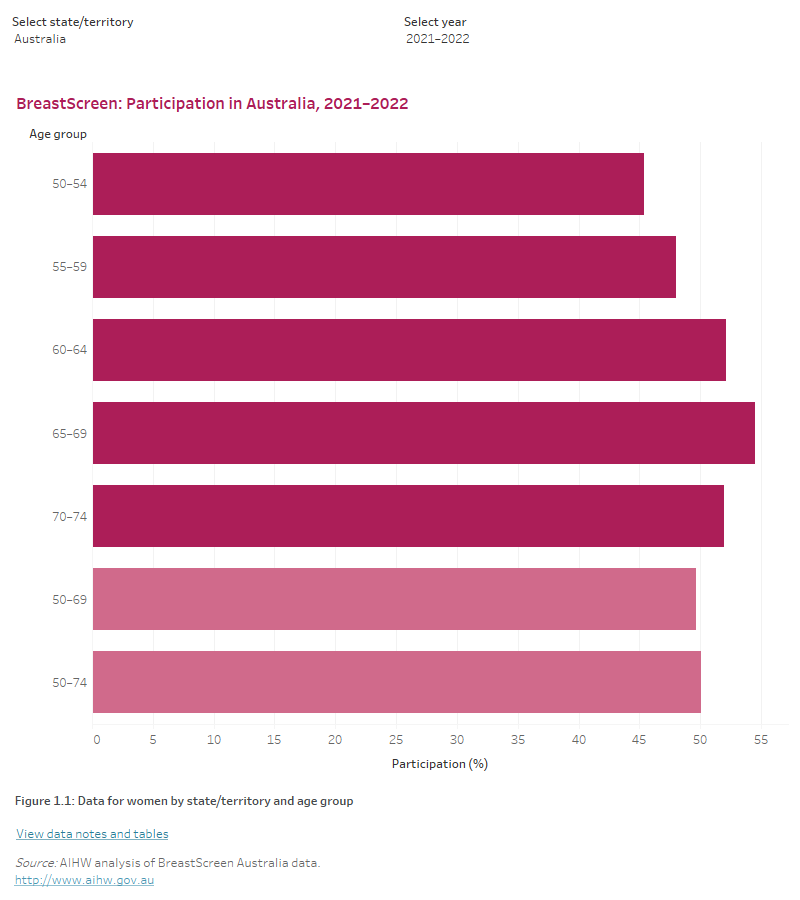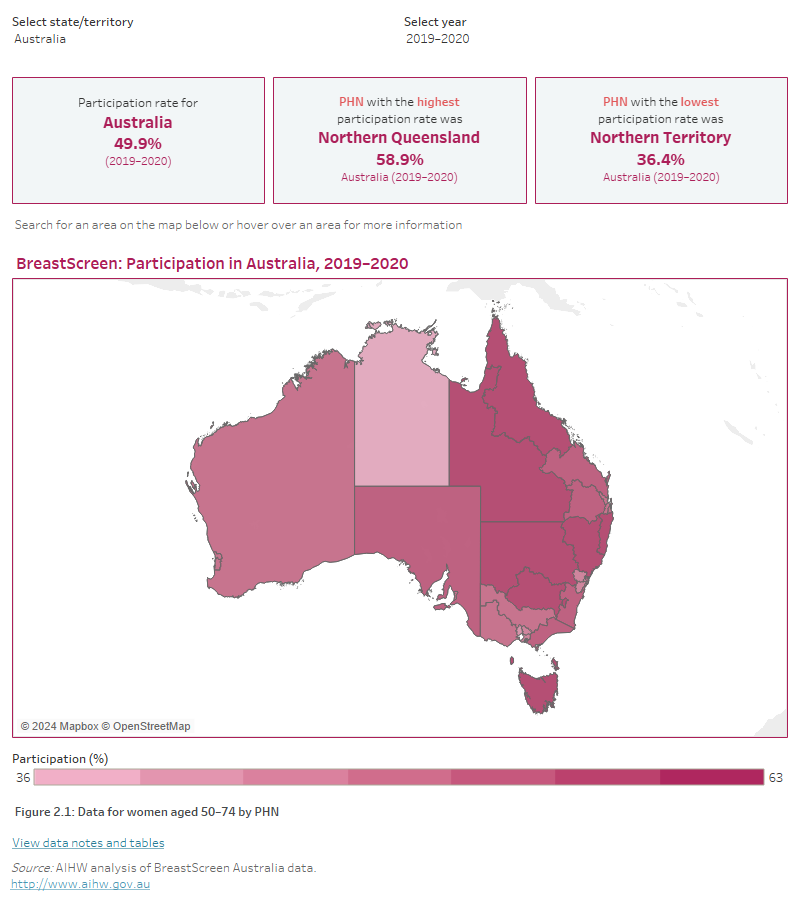Breast cancer screening participation
On this page:
Participation in BreastScreen Australia refers to the proportion of women aged 50–74 who are screened in a 2-year period.
Participation in BreastScreen Australia is measured over 2 calendar years to align with the recommended screening interval.
Explore the latest data in the visualisation below.
Participation in BreastScreen Australia
According to the 2021–2022 preliminary data:
- About 1.8 million of the 3.6 million women aged 50–74 who were eligible for screening mammograms participated in BreastScreen Australia.
- Half of the eligible women aged 50–74 (50%) has participated.
According to the 2021–2022 preliminary data:
- Women aged 65–69 had the highest participation rate of 54%.
- Women aged 50–54 had the lowest participation rate of 45%.
Trends in breast screening participation
- The number of women aged 50–74 who participated in BreastScreen Australia rose from about 1.7 million in 2014–2015 to almost 1.9 million in 2018–2019. This rise was expected and is explained by the full implementation of the changes in the target age group from 50–69 to 50–74 that occurred in 2017.
- In 2019–2020 the number of participating women fell slightly to almost 1.8 million and continued to fall in 2020–2021 to about 1.7 million before rising again to over 1.8 million in 2021–2022.
- The national age–standardised participation rate among women aged 50–74 remained around 54% between 2017–2018 and 2018–2019 and fell by 13% to 47% (or a 7 percentage points drop) in 2020–2021 before rising by 6% (or by 3 percentage points) in 2021–2022.
Participation by state/territory
According to the 2021–2022 preliminary data:
- The participation rate among women aged 50–74 was highest in Tasmania (59%).
- After adjusting for difference in population age structure across the states and territories, the participation rate in Tasmania (58%) was approximately 1.2 times higher than the national participation rate (50%) (age-standardised rates) with a difference of 8 percentage points between the two rates.
Figure 1: BreastScreen Australia participation data by state and territory, by age group and by year
This data visualisation shows participation data for BreastScreen Australia from 2014–2015 to 2021–2022 (preliminary). The bar graph on the first tab shows participation by age group and can be filtered by state/territory and year. The bar graph on the second tab shows participation by state and can be filtered by rate type (crude or age-standardised rate) and by year. The line graph on the third tab shows trend data by type of measure (number of participants, eligible population and participation rate), by state and territory and by age group. A fourth tab shows the participation data in table form and can be filtered by measure, by state and territory and by age group.

Geographical variation in breast cancer screening participation
Exploring participation across different geographical areas can help to identify where resources are needed to improve equity, accessibility, and participation in cancer screening programs and can inform strategies to improve screening rates among defined target groups.
Explore the latest geographical data in the visualisations below.
Participation by Primary Health Networks
Primary Health Network areas (PHNs) consist of 31 health regions across Australia whose purpose is the improvement of population health outcomes and regional coordination of health services in Australia (DHAC 2022).
In 2019–2020:
- Northern Queensland had the highest participation rate among PHN areas (59%).
- Northern Territory had the lowest participation rate (36%).
Figure 2: BreastScreen Australia participation rates for persons aged 50-74 by PHN
This data visualisation shows final participation data for BreastScreen Australia by Primary Health Network. The map can be filtered by state/territory and by year and uses shaded areas of colour to show participation rates. The bar graph on the second tab can be filtered by age group and by year and shows the participation rate of each Primary Health Network for the selected period. A third tab shows the participation data by Primary Health Network in table form and can be filtered by measure (number of participants, eligible population and participation rate), by state/territory and by age group.

Participation by Statistical Area Level 3
Statistical Areas Level 3 (SA3s) consist of 333 geographical areas of Australia from the Australian Statistical Geographical Structure (ASGS), defined by the Australian Bureau of Statistics (ABS) (ABS 2021).
In 2019–2020:
- Charters-Towers-Ayr-Ingram (Queensland) had the highest participation rate among SA3s (67%).
- Katherine (Northern Territory) had the lowest participation rate (20%).
Figure 3: BreastScreen Australia participation rates for persons aged 50-74 by SA3
This data visualisation shows final participation data for BreastScreen Australia by Statistical Area Level 3. The map can be filtered by state/territory and by year and uses shaded areas of colour to show participation rates. The bar graph on the second tab can be filtered by state/territory, by age group and by year, and shows the participation rate of each Statistical Area Level 3 for the selected period. A third tab shows the participation data by Statistical Area Level 3 in table form and can be filtered by measure (number of participants, eligible population and participation rate), by state and territory and by year.

References
ABS (Australian Bureau of Statistics) (2021) Australian Statistical Geography Standard (ASGS): Volume 3 – Main Structure and Greater Capital City Statistical Areas – Statistical Area Level 3, July 2021, catalogue number 1270.0.55.003, ABS, Australian Government, accessed 6 December 2022.
DHAC (Department of Health and Aged Care) (2022) Primary Health Networks (PHNs), Health website, accessed 6 December 2022.


